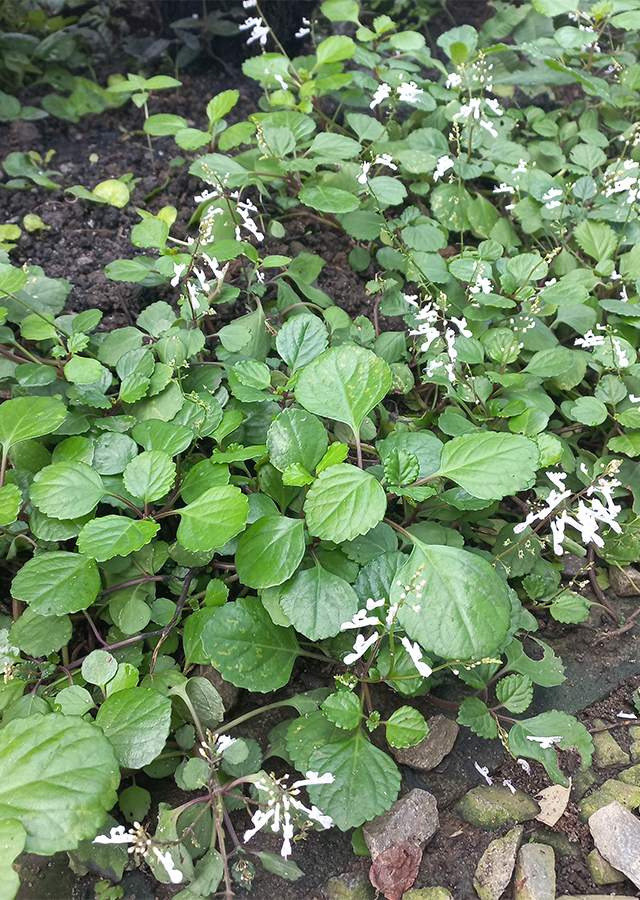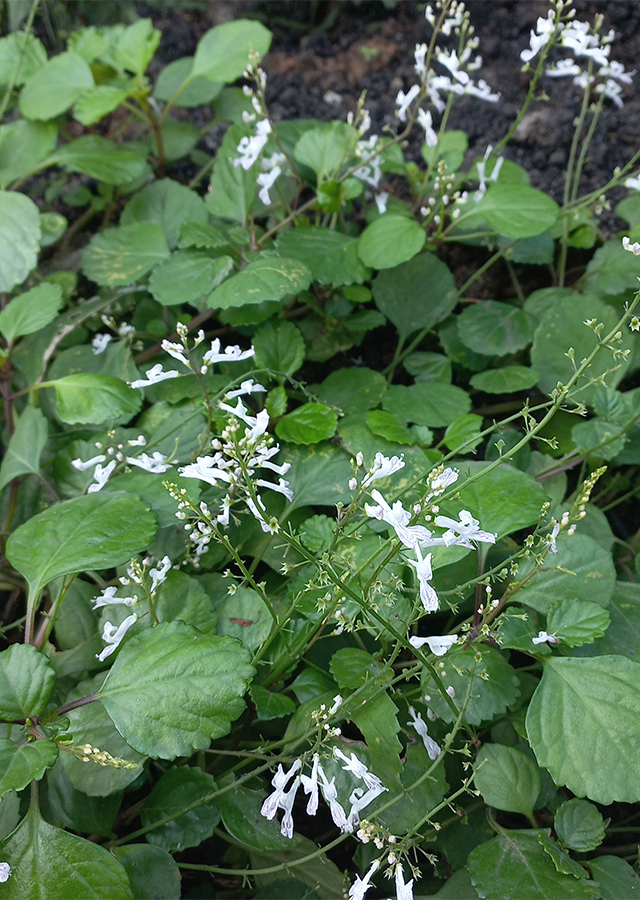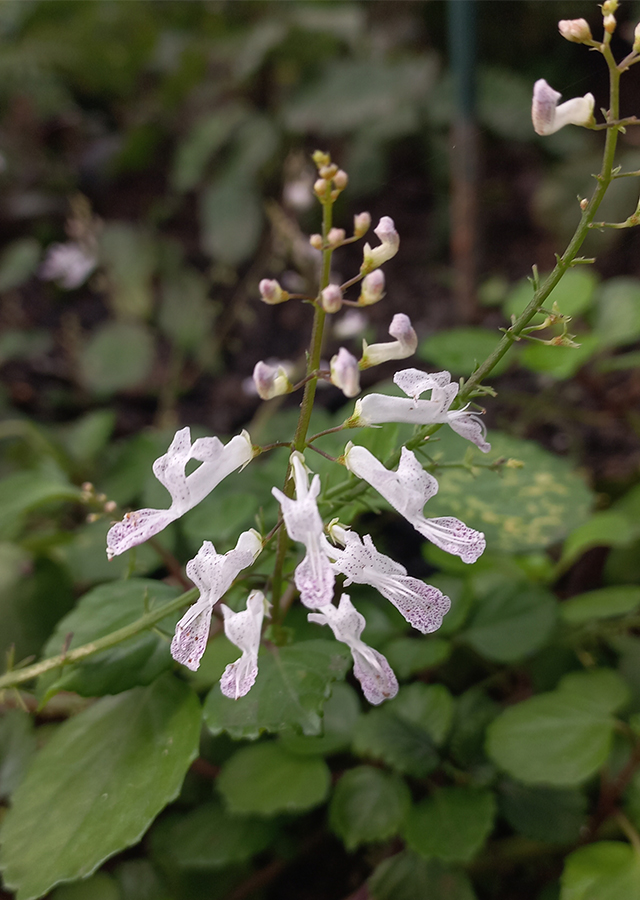Swedish Ivy
Plectranthus verticillatus (L.f.) Druce
Lamiaceae
Location in our garden
Principal



Synonym
Ocimum racemosum Thunb.
Ocimum verticillatum L.f.
Plectranthus nummularius Briq.
Habitus
Herbaceous. An aromatic evergreen semi-succulent perennial herbs forming a mat to 10-30 cm tall, with a spread of about 60 cm
Part Used
Leaves
Growing Requirements
Full Sunshine
Need Shade
Habitat
Forest
Terrestrial
Overview
Plectranthus verticillatus is a plant in the family Lamiaceae, ground cover native to southern Africa where it occurs in the Cape Provinces, KwaZulu-Natal, Swaziland, the Northern Provinces and southern Mozambique. It is found naturalized in El Salvador, Honduras, the Leeward Islands, the Venezuela Antilles, the Windward Islands, Venezuela, Puerto Rico, Hawaii as well as south-east Queensland and coastal areas of New South Wales in Australia. Plectranthus from plektron - a spur, referring to the spur at the base of the flower tube, and anthos - flower; verticillatus - whorled, referring to the inflorescence. It has long been a popular garden subject in many parts of the world, both for its attractive foliage as well as for its delicate white to pale mauve flowers. Swedish ivy is not native to Sweden, and is not closely related to the genus of ivy (Hedera), but it gets its name from the fact it was first popularized in Sweden.
Vernacular Names
No found data on this. Need further research.
Agroecology
Swedish ivy occurs in frost-free areas along forest margins, in woodland, kloof forest and scrub fores. It needs full sun to partial shade with a rich, well-drained soil mix. It is sensitive to frost. Plants are well watered and allowed to dry slightly before watering again. If the plants get too wet they develop root rot. During summer, plants are fertilized monthly with a balanced fertilizer. Prune young plants to create bushy growth.
Morphology
- Stem - branching, procumbent to ascending, short, strigose (short rough hairs pointed in the same direction), up to 2 m long.
- Leaves - glossy, soft, round to obovate, light to dark green above, sometimes deep purple below, semi-succulent (64-90 mm across) with crenate to broadly-toothed margins borne on rectangular stems.
- Flowers - white, pale mauve, or pale pink flowers appear sporadically throughout the year in gardens but more abundantly in spring and late autumn. Inflorescence terminal, racemose, verticillate (whorled), 50-260 mm long, often with paired side branches (verticillasters) at the base. Calyx 3 mm long enlarging to 5 mm. Corolla 10-25 mm long, white, often speckled.
- Fruit - tube 4-16 mm long, straight, laterally compressed, 2-3 mm broad, almost linear; base slightly saccate.
- Seed - nutlets 1 mm long, brownish.
Cultivation
- Generative propagation is by seed.
- Vegetative propagation is by stem cuttings and by division of larger plants.
- When established, plant out in beds with a well-drained mixture of bark (we use pine bark chips), sand and soil rich in humus in lightly shaded to full sunlight situations.
Chemical Constituents
Essential oils, diterpenoids, saponin.
Traditional Medicinal Uses
- It is used as expectorant in cough with phlegm and bronchitis, sore eyewash, to treat arthritis, gout, or rheumatism. Relieves pain from wounds or surgery by applying topically, releasing toxins from the body, thereby purifying the blood and reducing tension, reducing pain and the potential for infection of burns on the skin, psoriasis, eczema, acne, and other ailments other skin, asthma, respiratory tract infections and inflammation (Chronic Obstructive Pulmonary Disease), prevent the spread and development of cancer and chronic diseases.
- Studies have shown antibacterial, antiinflammation, antifungal and antitumoral.
Part Used
Reference Sources
- Abdel-Mogib, M., Albar, H.A., and Batterjee, S.M. (2002). Chemistry of the Genus Plectranthus. National Library of Medicine, 7(2): 271–301. doi: 10.3390/70200271.
- Kew Royal Botanic Gardens. (No date). Plants of the World Online: Plectranthus verticillatus (L.f.) Druce. https://powo.science.kew.org/taxon/urn:lsid:ipni.org:names:454770-1. 11-04-2022.
- Khanyile, Senzo. (2010). Plectranthus verticillatus. http://pza.sanbi.org/plectranthus-verticillatus. 11-04-2022.
- RHS. (No date). Plectranthus verticillatus. https://www.rhs.org.uk/plants/13263/plectranthus-verticillatus/details. 11-04-2022.
- Rice, L.J., Brits, G.J., Potgieter, C.J., and Van Staden, J. (2011). Plectranthus: A plant for the future?. South African Journal of Botany. Vol 77(4): 947-959. Also available: https://www.sciencedirect.com/science/article/pii/S0254629911001050.
- World of Succulents. (No date). Plectranthus verticillatus (Swedish Ivy). https://worldofsucculents.com/plectranthus-verticillatus-swedish-ivy/. 11-04-2022.

